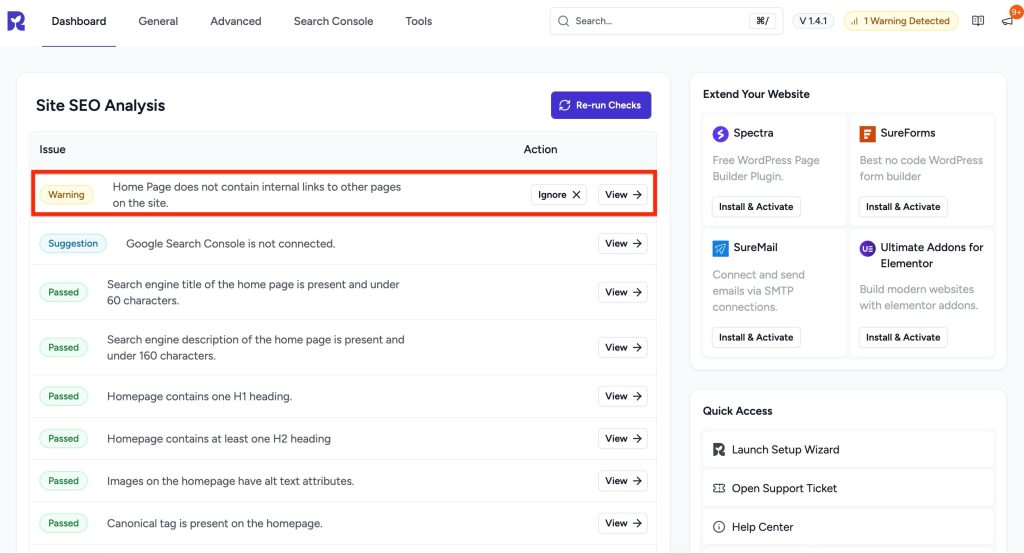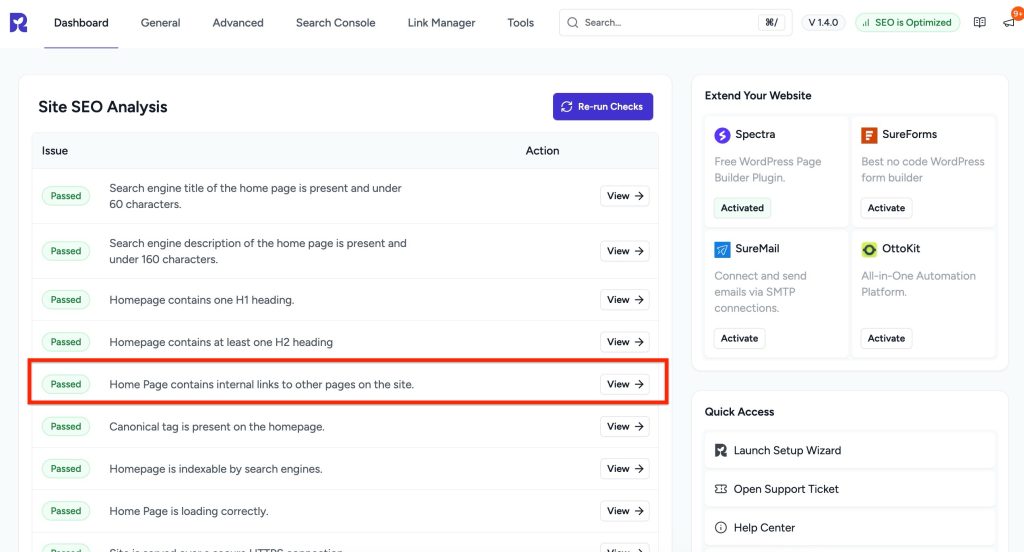- Sitemaps in SureRank
- How to Enable Video Sitemap in SureRank Pro
- How to Enable the News Sitemap in SureRank
- How to Show the HTML Sitemap on Your Site in SureRank Pro
- How to Regenerate the Sitemap After Excluding a Post Type in SureRank
- Change the Sitemap URL in SureRank
- How to Enable Author Sitemap in SureRank
- How to Fix WWW and Non-WWW Version Redirects to Improve Your SEO
- How to Fix: No H1 Heading Found on Your Homepage
- How to Fix Missing H2 Headings on Your Homepage
- Re-run Checks Button in SureRank
- Fix Critical Error: Another SEO Plugin Detected in SureRank
- Fix Warning: Site Tagline Is Not Set in SureRank
- How to Fix Multiple SEO Plugins Detected on Your Site
- How to Fix: Homepage is Not Indexable by Search Engines
- Warning: Homepage Does Not Contain Internal Links
- How to Fix Missing Alt Text on Homepage Images
- How to Fix Missing Canonical Tag on Your Homepage
- How to Fix Missing Open Graph Tags on Your Homepage
- How to Fix Missing Structured Data (Schema) on Your Homepage
- How to Fix XML Sitemap is Not Accessible in SureRank
- How to Fix Search Engine Visibility Blocked in WordPress
- Connect Google Search Console
- How to Fix Site Not Served Over HTTPS in SureRank
- How to Fix Robots.txt File Accessibility Issues in SureRank
- How to Fix Missing Search Engine Title on Your Home Page
- How to Fix Home Page is Not Loading Correctly
- How to Fix No Images Found on the Homepage Warning
- SureRank – Internal Link Suggestions
- How to Fix: Search Engine Title is Missing on the Page
- Page Level SEO: Broken Links Detected
- How to Fix Missing Alt Text on Images
- How to Fix Page URLs That Are Too Long
- Page Level SEO Warning: No Links Found on This Page
- Page Level SEO Warning: No Images or Videos Found
- Page Level SEO Warning: Missing Search Engine Description
- Page Level SEO Warning: No Subheadings Found on This Page
- Page Level SEO Warning: Canonical Tag is Missing
- Page Level SEO Warning: Open Graph Tags Missing
- What is Google Search Console and how does SureRank use it?
- Recommended Image Sizes
- SureRank – SEO Check Severity Guide
- Using SureRank with Other SEO Plugins – Best Practices
- Import/Export Feature – SureRank Plugin
- What is llms.txt and Does SureRank Support It?
- Does SureRank offer a keyword rank-tracking feature?
- Does SureRank Come With Google Analytics Integration?
- Customize Final Title Tag surerank_final_title
- Customize Post Type Archive Title Output surerank_post_type_archive_title
- Customize Archive Page Title with surerank_archive_title
- CustomizeModify the Search Results Page Title surerank_search_title
- Customizing the 404 Page Title surerank_not_found_title
- Customizing the Title Separator surerank_title_separator
- How to Remove Archive Prefixes from Titles Using SureRank
- Customize Homepage Pagination Format surerank_homepage_pagination_format
- Customize Maximum SEO Title Length surerank_title_length
- Enable/Disable Pagination in SureRank Archives surerank_show_pagination
Warning: Homepage Does Not Contain Internal Links
If you see a warning in SureRank saying: “Home Page does not contain internal links to other pages on the site“.

This article will explain what it means, why it’s important, and how to fix it, even if you’re not a technical user.
What’s the Problem
Internal links are hyperlinks that point from one page of your website to another page on the same website. For example: linking from your homepage to a product page, blog post, or contact page.
When your homepage does not include internal links:
- Visitors have a harder time discovering other pages on your site
- Search engines like Google cannot easily crawl and index your pages
- SEO value (link equity) is not passed effectively to important pages
Examples of missing internal links:
- Homepage has only text, images, or buttons linking to external sites
- No menu, featured content, or call-to-action blocks linking internally
Why This Matters
Internal linking is a key SEO practice because it:
- Improves site navigation: Helps visitors easily explore your website.
- Distributes page authority: Passes SEO value from high-authority pages (like homepage) to other pages.
- Enhances indexing: Search engines discover your pages faster and understand their hierarchy.
- Boosts user engagement: Encourages visitors to view more pages, increasing time spent on your site.
How to Fix
Step 1 – Add Internal Links to Key Pages
- Identify important pages you want to promote (products, services, blog posts, contact page).
- Add links to these pages directly from your homepage content.
Examples:
- Featured Products: Add “View Product” links to product pages.
- Blog Highlights: Link article titles to their respective posts.
- Call-to-Actions: Use buttons like “Learn More” linking internally.
Step 2 – Use Menus or Navigation Blocks
- Ensure your main navigation menu includes links to key sections of your site.
- Consider adding footer menus or sidebar links for additional navigation paths.
Step 3 – Use Contextual Links Within Content
- Add relevant internal links naturally within your homepage text.
- Example: “Check out our latest courses” linking to the courses page.
Step 4 – Re-run Site SEO Analysis
- After making changes, Re-run Checks in SureRank.
- The warning should disappear. Home Page contains internal links to other pages on the site.

Best Practices
- Avoid adding too many links; focus on relevant and useful connections.
- Use descriptive anchor text, not generic phrases like “click here.”
- Update internal links regularly as you add new pages or content.
Was this doc helpful?
What went wrong?
We don't respond to the article feedback, we use it to improve our support content.
On this page